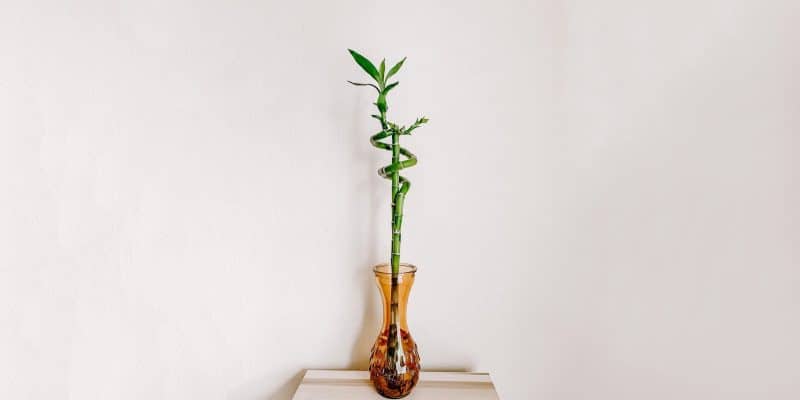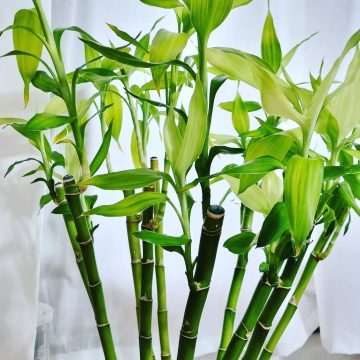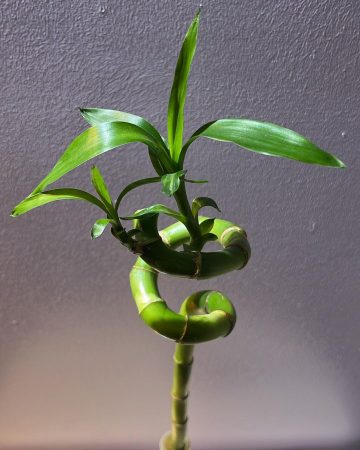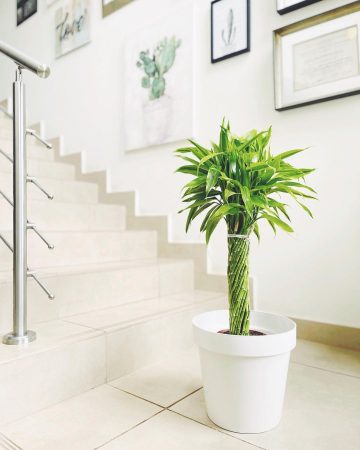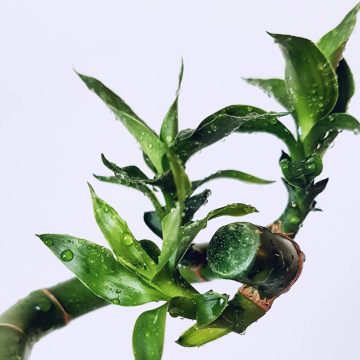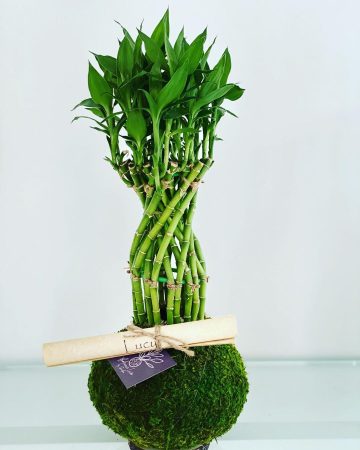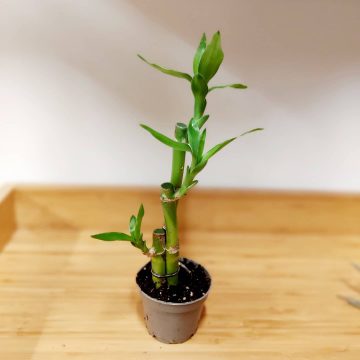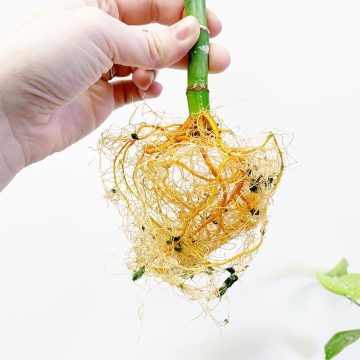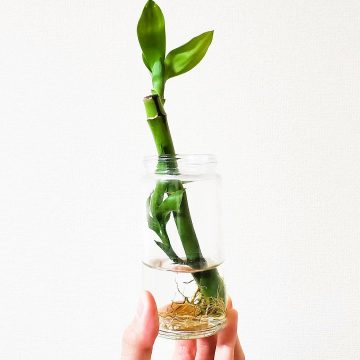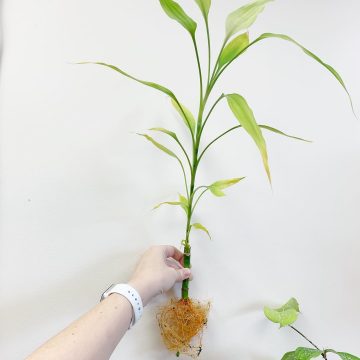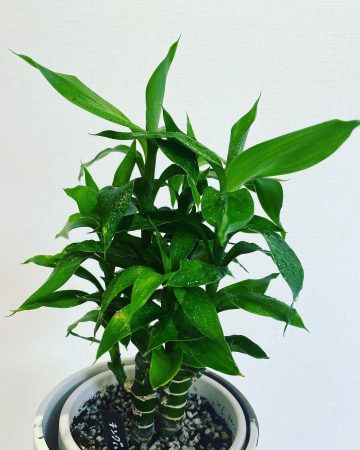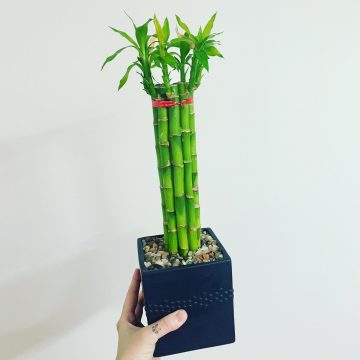Ever felt the power of Lucky Bamboo (Dracaena sanderiana), a wave of green goodness radiating from a little bamboo forest?
Maybe not yet. But don’t worry, you don’t need a green thumb to bring that positive energy into your own space. Lucky Bamboo is a low-maintenance, charming houseplant that even the most forgetful beginner plant parents can keep alive.
We’ll cover everything you need to know about Lucky Bamboo care in this article — it’s actually a lot easier than you might think. We’ll tell you all about what it symbolizes in feng shui, the ideal conditions for its growth, and how you can use it to spruce up your home decor (pun intended).
Let’s dive right in and spread the good fortune!
Table of Contents
Lucky Bamboo Plant Care Guide
History, Habitat, and Characteristics
Imagine having a houseplant that not only adds charm to your space but also brings good fortune and positive vibes. We’re talking about Lucky Bamboo, or Dracaena sanderiana, an indoor plant with serious good juju.
Don’t be misled by its name, though – Lucky Bamboo isn’t a true bamboo, but rather a member of the Dracaena family. Native to Africa’s tropical rainforests, this striking bright green plant has won hearts far beyond its homeland, becoming a favorite in Asia and Europe.
So what’s all the fuss about?
Lucky Bamboo has twisted or spiraled stems, also giving it the nickname Curly Bamboo, topped with lush green leaves that contrast beautifully. It’s easy to grow and adapts well to various indoor conditions, making it perfect for both seasoned plant parents and those just starting their green journey.
The Meanings Behind Lucky Bamboo Stalks
The Lucky Bamboo plant holds a special place in the ancient Chinese practice of feng shui. It symbolizes harmony, balance, and positive energy.
Depending on the number of stalks, Lucky Bamboo can also signify different aspects of life, like happiness, wealth, or longevity. Each number of stalks has its own symbolic meaning, and is thought to attract different kinds of luck and blessings.
Here are the meanings behind the number of stalks in a Lucky Bamboo arrangement:
- One stalk symbolizes simplicity, strength, and resilience. It is believed to help maintain a strong, healthy life and overcome challenges.
- Two stalks represent love and partnership. They are often gifted to couples or used to strengthen existing relationships, as they symbolize a harmonious and happy union.
- Three stalks symbolize happiness, wealth, and long life. This combination is believed to bring a well-rounded and fulfilling life.
- Four stalks is often associated with bad luck, as it sounds similar to the word for “death.” Therefore, four stalks of Lucky Bamboo are generally avoided as a gift.
- Five stalks represent the five elements of feng shui: wood, water, fire, earth, and metal. They are believed to bring balance and harmony to all aspects of life.
- Six stalks symbolize wealth and prosperity, particularly in terms of career and financial success.
- Seven stalks represent growth (in the personal sense) and good health.
- Eight stalks symbolize growth and abundance. In Chinese culture, the number eight is considered particularly lucky, as it sounds like the word for “prosper” or “wealth.”
- Nine stalks represent great luck and completion. They are thought to bring a sense of fulfillment, happiness, and overall satisfaction with life.
Light
Lucky Bamboo plants prefer indirect sunlight rather than direct sun, which can lead to scorched or crispy leaves.
Keep your bamboo plant happy by placing it near the corner of a window, where it receives bright indirect sunlight, ensuring it won’t be exposed to too much sun. Although Lucky Bamboo can handle darker corners of your home, it won’t reach its full potential and grow as bushy and tall as it could in indirect sunlight.
Lucky Bamboo can manage medium to low light conditions, but its growth will be a bit slower compared to when it receives brighter light.
Our lighting tips:
- Keep your Lucky Bamboo in a spot where it won’t be exposed to direct sunlight; this helps prevent scorching and crisping of the leaves.
- Place your bamboo plant near the corner of a window to ensure access to indirect, diffused light.
- Less light means slower growth. While Lucky Bamboo plants will survive in lower light, they can lose their green luster.
Water
Although Lucky Bamboo, also called Ribbon Plant or Friendship Bamboo, is a fan of water, it’s crucial to avoid letting it dry out completely. Inconsistent watering can lead to yellowing and crisping of the plant’s leaves. To prevent this from happening, water Lucky Bamboo indoors once a week during summer and cut back to once every two weeks during winter months.
Avoid using gravel in the water for Lucky Bamboo, as it can lead to issues with the plant’s roots.
Now, let’s talk about the signs of underwatering. If your bamboo plant isn’t getting enough water, you might notice:
- Yellowing of the leaves, particularly at the tips
- Crisping of the leaves
- A general drooping appearance
To fix this, simply increase how frequently you water and keep an eye on your plant to make sure it’s recovering.
Some signs of overwatering include:
- Yellowing leaves throughout the entire plant
- A foul smell or black, mushy roots, indicating issues with the roots
- Wilting or limp leaves, even though the soil remains moist
In case your plant shows signs of overwatering, cut back on the watering frequency and let the soil dry out a bit before resuming.
Our watering tips:
- Check the soil moisture by sticking your finger about an inch into the soil. You’ll want it to be approaching dryness before watering.
- When you water, make sure you do so thoroughly, so that the water reaches the roots and drains well. This helps prevent standing water.
- Use room temperature water, preferably bottled water or distilled water to avoid any tap water chemicals that may affect Lucky Bamboo.
- Stay away from using gravel in the water — this can increase the risk of issues with the roots.
Temperature and Humidity
Lucky Bamboo thrives in comfortable indoor temperatures between 60-75°F. Keep your bamboo plant in a cozy room away from cold drafts or extreme heat. If you notice any yellow leaves or slow growth, it might be a sign that your Lucky Bamboo is exposed to temperatures outside of its preferred range.
Lucky Bamboo enjoys a moderate humidity level, similar to most indoor environments. However, if you notice the tips of the leaves turning brown or curling, this could be a sign that the humidity is too low for your plant. If the stalks or leaves become soft and mushy, it may indicate that the humidity is too high, leading to rot and other issues.
Soil and Planting
Lucky Bamboo (Dracaena sanderiana) is often grown in water, but it actually thrives best in moist soil.
To achieve the best growth for your Lucky bamboo plant, use a well-draining potting mix with a slightly acidic to neutral pH (6.0-7.0). A mix of regular potting soil, peat moss, and perlite works well.
You can experiment with the proportions, but we suggest starting with a mix of:
- 50% potting soil
- 25% peat moss (for moisture retention)
- 25% perlite (for aeration)
If your Lucky Bamboo is planted in poor soil, it may exhibit symptoms such as yellowing leaves, stunted growth, or weak stems. Using the wrong potting mix can lead to problems like inadequate nutrient absorption. To avoid these issues, ensure your potting mix drains well while still retaining enough moisture to support the plant’s growth.
Fertilizer
Lucky Bamboo plants benefit from a nitrogen-rich fertilizer, as they don’t need to produce flowers or fruits. Fertilize your plant with a weak liquid fertilizer (you can use specialty Lucky Bamboo fertilizers like an organic manure or liquid seaweed fertilizer) every two months.
Signs of too much fertilizer include browning leaf tips, sudden leaf drop, or a general decline in the plant’s health.
If you suspect over-fertilizing, stop providing fertilizer right away and flush the soil with water to help remove excess nutrients. Resume after a month, but make sure to start slowly and heavily diluted.
Propagation
Want to propagate Lucky Bamboo? It’s super easy, so let’s get right into how to spread that luck around.
Propagating Lucky Bamboo by stem cutting:
- Find a healthy, green, and happy-looking Lucky Bamboo stem with several leaves and nodes. Remember, a healthy plant is the key to success!
- Clean and sterilize your gardening shears and grab a small container filled with water. This will make sure your cutting process is nice and clean.
- Cut a 4-6-inch segment from the stem at a 45-degree angle, ideally just below a leaf joint. This angle helps the cutting drink up more water and grow those roots faster.
- Gently remove the leaves from the bottom nodes of your cutting, leaving 2-3 healthy leaves at the top. This makes room for the roots and keeps the leaves from rotting in the water.
- Pop your cutting into the container filled with fresh water, making sure the nodes are submerged, but not the leaves. This will help those roots grow nice and strong.
- Place your container in a well-lit area, but avoid harsh sunlight or too much sun, so you don’t cook your little plant buddy.
- Change the tap water every 2-3 days, so it stays clean and bacteria-free for your Lucky Bamboo cutting to thrive.
- In a couple of weeks, you’ll see healthy white roots start to grow. When they reach at least an inch long, it’s time to move your cutting to its new home.
- Gently dig the rooted cutting into a pot with well-draining soil and give it a good soak. Keep this new little plant in a bright spot with indirect sunlight and water it weekly, letting the soil dry out a bit between waterings.
Common Issues
Sometimes even the hardiest Lucky Bamboo plants can face a few issues, but we’re here to help you identify and fix the most common ones we see.
Yellow Leaves
Yellow leaves are often caused by too much direct sunlight or inconsistent watering. Imagine your plant asking for some partial shade and a refreshing drink. Picture those vibrant yellow, even translucent, leaves as a cry for help.
What’s the fix? First, move your Lucky Bamboo away from direct sunlight, and set it up in a spot with bright, indirect light.
Next, keep its water clean and fresh, changing it every 7-10 days if planted in water. Oh, and avoid tap water with high chlorine content — distilled or filtered water is your plant’s best friend!
Crispy Leaves with Brown Tips
Brown leaf tips can be a sign of rotting roots or excess minerals in the water. Rot might happen if you’ve been using gravel in the water or if your bamboo plants have been sitting in stagnant, dirty water for too long. Look for those brown, crispy edges on leaves and any mushiness or decay on stems—that’s how you know there’s a problem.
To fix it, gently remove your Lucky Bamboo plant from its container and trim away any rotten or decaying roots. Clean the container thoroughly and replace the water with fresh, clean water. If you’re using gravel, give it a proper rinse before putting it back in.
If crispy brown leaves and tips persist, try switching to distilled or filtered water, just like we did for issue #1. Stick to a consistent watering schedule and keep an eye on your plant.
Pests and Diseases
Like any other houseplant, Lucky Bamboo can have its share of pests and diseases . . . but with a little care, you’ll have your plant back on track in no time. We’ll cover the two most frequent problems we see: insects and root rot.
Insects
Those annoying little bugs, like mealybugs, aphids, spider mites, and scale, can cause damage to your Lucky Bamboo plant if not dealt with promptly. Keep an eye out for tiny bugs, webbing, or sticky residue on the leaves and stems — those are telltale signs something’s up. And don’t forget to keep dead leaves away from your plant, as they can attract pests like a cozy little hotel.
To fix an insect issue, you’ll want to get some neem oil — it’s an organic remedy for these common pests. Apply the oil every two weeks until your plant is bug-free. Make sure you spray every nook and cranny, including the stems and both sides of the leaves.
Adding moisture to your plant’s environment can also help deter mites. Consider placing your Lucky Bamboo in a tray with a layer of pebbles and water. This will increase humidity around the plant, making it less appealing to spider and other mites, since they’re not big fans of moisture.
To prevent future insect infestations, take good care of your plant — clean the leaves regularly, provide enough light, and water it correctly.
Root Rot
The Lucky Bamboo plant isn’t lucky enough to be immune to this problem, which occurs when roots suffocate and rot due to soil staying too wet for too long. It’s usually caused by overwatering or poor drainage.
If you suspect rotting roots, look for yellowing or wilting leaves, an unpleasant smell, and black or brown mushy roots. Carefully remove your plant from its container and examine the roots — those are the clues you need!
Trim away any affected roots with sterilized scissors (and make sure to clean the scissors before and after with boiling water or alcohol to prevent the spread of disease). Repot your Lucky Bamboo in fresh, well-draining soil, and add some perlite or pumice to improve drainage. Choose a container with drainage holes, because we don’t want water pooling at the bottom.
Conclusion
That’s it for our Lucky Bamboo care guide! With its fascinating feng shui association and impressive resilience, it’s no wonder Dracaena sanderiana (yep, not a real bamboo!) is a go-to plant for beginners and experts alike.
Lucky Bamboo care tips summary:
- Provide bright, indirect light (avoid too much sunlight) to keep your Lucky Bamboo happy and ensure steady growth.
- Maintain consistent water levels and avoid letting your plant dry out completely. Use filtered or distilled water instead of tap water to avoid excess minerals and chlorine.
- Keep your plant cozy in a room with moderate temperatures between 60-75°F and protect it from drafts or extreme heat.
- Use well-draining soil made of potting soil, peat moss, and perlite to support healthy root growth and prevent issues like rotting roots.
We hope this guide answered all your burning questions about how to care for Lucky Bamboo. If you found it helpful, be sure to share it with a fellow plant lover. And, as always, feel free to reach out (we’d love seeing photos of your Lucky Bamboo in action!).
Take care, and lucky growing!
FAQ
Does Lucky Bamboo need soil or rocks?
The Lucky Bamboo plant can grow in both!
When growing Lucky Bamboo in soil, you’ll want to choose a light and well-draining potting mix. This helps ensure that the roots don’t get waterlogged, which can lead to rot. Just make sure you’re keeping the soil consistently moist, as Lucky Bamboo doesn’t appreciate being left high and dry.
If you’re more of a rock person, you can grow your Lucky Bamboo plant in water with some pebbles or small stones. This setup not only looks elegant but also helps anchor the plant as it grows. Just remember to keep the water level high enough to cover the roots and change it every week or so to keep things fresh and algae-free.
How big do Dracaena sanderiana get?
In their natural habitat, these plants can reach heights of 3 to 5 feet tall, but don’t worry, your indoor plant won’t become a towering, leafy giant overnight.
When properly cared for, an indoor Lucky Bamboo plant typically grows to about 2 to 3 feet tall, spreading its vibrant green leaves to create a calming display of charm and positive energy.

